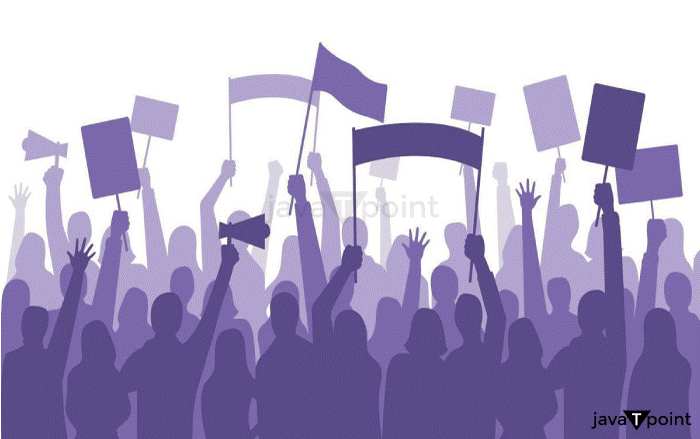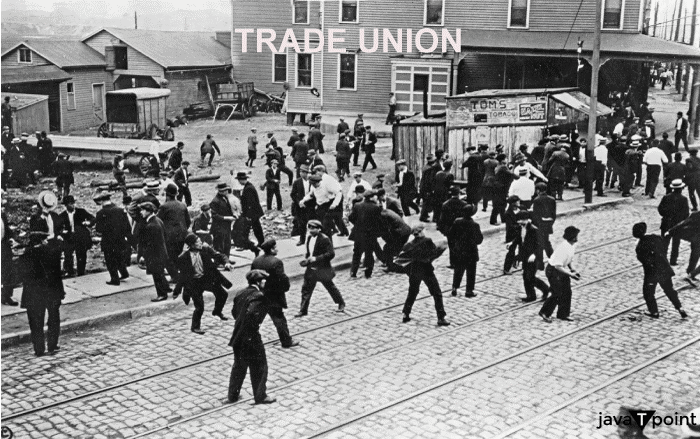Trade Union DefinitionA trade union is a group that works to advance the rights of employees in a certain sector or line of activity. It is sometimes called a guild, trade organization, or labor union. A trade union's primary goal is to bargain with employers on behalf of its members to raise working standards, pay, and benefits. 
Typically, workers who have common interests and objectives form trade unions. They could share a profession or sector, or their abilities or credentials might be comparable. Trade unions exist in many sectors, including industry, healthcare, education, and transportation. A trade union's main duty is to represent its members' interests while collectively bargaining with employers. In order to come to an agreement on pay, benefits, and other terms of employment, the union bargains with the employer. The union may also offer its members assistance in the form of training, education, and legal representation. Additionally, trade unions play a political role by lobbying governments to enhance working conditions and uphold workers' rights. Additionally, they might participate in social activism by promoting social justice and helping local causes. Definition Of Trade UnionA union is an organisation created by employees of a particular business, industry, or sector to represent and defend their rights and interests as a group. Another way to think of a union is as a group of employees who get together to advance and defend their constituents' political, social, and economic interests. To improve working conditions, pay, benefits, and other workplace rights, unions strive to bargain with employers on behalf of their members. In the event of disagreements or complaints, they may also offer legal and financial support to its members. During the Industrial Revolution, workers were exploited and mistreated, which led to the idea of creating unions. Workers came to understand that by uniting, they could bargain with their bosses on their behalf and better working conditions. In many nations today, unions are recognised and given legal protection. They are crucial in defending worker rights, enhancing conditions and safety on the job, and advancing social and economic justice. History Of Trade UnionsAssociations of employees, known as trade unions, were created to protect their rights and enhance working conditions. Trade unions have a long history, dating back to the European Industrial Revolution, when employees had to contend with poor working conditions, low pay, and lengthy workdays. The history of trade unions in India and the rest of the globe will be examined in this piece. Smaller worker organisations began to form in Britain in the 18th century. Still, they were sporadic and short-lived for most of the 19th century, partly due to the hostility they encountered from employers and government organisations who disapproved of this new form of political and economic activism. At that time, in Britain and the United States, numerous restraint-of-trade and conspiracy legislation was frequently used to punish unions and unionists. The Friendly Society of Agricultural Labourers, founded in England in 1765, was the first trade union ever officially recognised. Trade unions were not allowed in the early days and employees who did so risked being disciplined or dismissed from their positions. However, legislation protecting their rights was passed as a result of worker organisation and political pressure. An important turning point in the development of trade unions was the founding of the International Workingmen's Association, often known as the First International, in 1864. This organisation brought together employees from many nations with the goal of fostering worker solidarity on a global scale. The Trade-Union Act of 1871 served as the legislative foundation for British union membership. A number of court rulings that reduced the use of injunctions, conspiracy laws, and other tactics against unions in the United States led to a similar impact, albeit more gradually and uncertainly. An early attempt to establish a federation of American unions was made in 1866 with the founding of the National Labour Union (NLU). Several of the NLU's affiliate trade unions persisted after it ceased to exist in the 1870s, covering a variety of professions, including shoemakers, spinners, coal miners, and railway employees. Many nations established rules that supported unionisation and collective bargaining in the years following World War II. Strong unions were created in nations like Germany, France, and Italy during the post-war era. History Of The Unions In IndiaOur nation has had a trade union movement for a century. The trade union movement began in the first part of the twenty-first century, although its seeds were planted far earlier. The AII India Trade Union Congress (AITUC) was founded in 1920 to advocate for workers' rights, coordinate the efforts of all labour unions in the nation, and educate people about the need for unionisation. The passage of the Trade Unions Act in 1926 was a turning point in the history of the labour movement since, unlike the 1920s, the 1930s were unfavourable to the trade union movement. 167 trade unions had a quarter million members by 1924. India had a boom in militant trade unionism in the 1960s and 1970s, when unions organised rallies and strikes to call for higher pay and improved working conditions. However, economic liberalisation measures caused many state-owned businesses to close their doors and the informal sector to expand, which resulted in a loss in union influence in the 1980s and 1990s. Then, unions did not do well in the years after Independence. Workers had hoped that the national government would provide better facilities and pay, but this did not happen. There was widespread discontent, and the number of strikes and lockouts increased. Trade unions in India now confront a variety of difficulties, including as low membership, fragmentation, and rivalry from employees in the unorganised sector. They nonetheless continue to be very important in promoting workers' rights and enhancing working conditions. Some Of the Recognised Unions In IndiaIn India, there are several officially recognised trade unions in various industries. Among them are:
How Unions Are RegisteredThe actions listed below can be completed to register a union:
It is significant to note that the stages or regulations for registering a union may differ depending on the nation. An experienced union organizer or attorney should be consulted for advice on the registration procedure. 
Categorization Of Trade UnionsTrade unions can be grouped based on their degree of operation, membership, and goals. 1. Type of Operation Undertaken
2. Based on Competitiveness
3. Based on Objectivity
There also exist "Federations" that are top national organisations associated with plant-level unions, craft unions, industrial unions, and general unions. They manage the business of different unions under their umbrella. Functions Of Trade UnionsBroadly the function of trade unions can be divided into two parts:- internal/external OR Representational/Societal duties.
Next TopicTrial Balance Definition
|
 For Videos Join Our Youtube Channel: Join Now
For Videos Join Our Youtube Channel: Join Now
Feedback
- Send your Feedback to [email protected]
Help Others, Please Share










